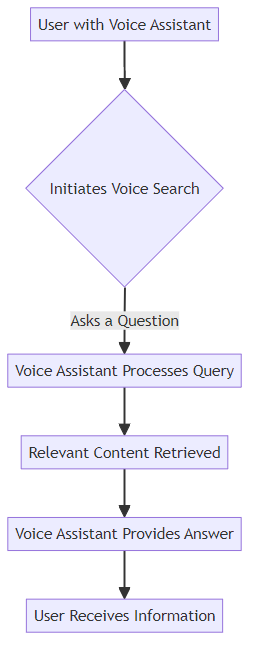Optimizing AI-Generated Content for Voice Search: A Marketer's Guide
The Rise of Voice Search and AI-Generated Content
Did you know that over one billion voice searches are made every month? Optimizing content for voice search is no longer optional—it's essential for marketers seeking to stay ahead.
Voice search is gaining traction due to user-friendly smart speakers and virtual assistants. People enjoy the convenience and hands-free nature of voice, particularly on mobile. As voice search continues to expand, it's reshaping SEO strategies.

Ai writing assistants have become crucial for content creators. They can quickly generate blogs, social media posts, and product descriptions. However, ai-generated content often lacks a natural, human-like tone. Balancing ai's efficiency with a conversational style is critical for voice search optimization.
For instance, in healthcare, ai can draft responses to common patient queries, but a human touch is needed to ensure empathy. In retail, ai can generate product descriptions, but customer reviews provide valuable natural language insights. In finance, ai can summarize market trends, but human analysts must refine the content for clarity. According to Voice Search Optimization: Prepare Your Content for the Future - HumansWithAI, users often exhibit higher purchase intent when conducting local voice queries.
As we move forward, it's clear that marketers must adapt to this evolving landscape. The next section will cover optimizing existing content for voice search.
Understanding Voice Search Queries
Did you know that voice search queries are fundamentally different from typed ones? Understanding these differences is key to capturing this growing market segment.
Voice search queries tend to be longer and more conversational than text-based searches. Users speak in full sentences and often phrase their queries as questions. For example, instead of typing "Italian restaurants," a user might ask, "What are some good Italian restaurants near me that are open now?" This conversational style requires a shift in keyword strategy.
- One key difference is the use of interrogative words such as "what," "where," "how," and "why." People use these words to frame their questions naturally.
- In healthcare, a patient might ask, "What are the symptoms of the common cold?" rather than typing "cold symptoms."
- In finance, an investor might ask, "How does inflation affect my investment portfolio?" instead of typing "inflation investment impact."
- In retail, a customer might ask, "Where can I buy organic apples?" instead of typing "organic apples."
Keyword strategies must adapt to these conversational patterns to effectively capture voice search traffic.
Long-tail keywords are crucial for voice search optimization. These longer, more specific phrases reflect the way people naturally speak and think.
- For instance, instead of targeting "coffee," focus on "where can I find a good latte near me with oat milk?"
- Semantic search focuses on understanding the intent and context behind a query. Content must be comprehensive and highly relevant to rank well. Ai tools can help marketers understand user intent by analyzing search patterns and conversational nuances.
As Christine Colucci, a noted voice search expert, notes on LinkedIn, in a world of voice search, there’s no scroll, no list, no second chance. There’s just one answer. One brand. One name.
- Retailers can optimize for semantic search by creating detailed product descriptions that answer common customer questions.
- Healthcare providers can provide comprehensive information about medical conditions and treatments.
- Financial institutions can offer in-depth analyses of market trends and investment strategies.
Optimizing for long-tail keywords and semantic search will significantly improve your visibility in voice search.
Understanding these key differences between voice and traditional search will help you create content that resonates with voice search users. Now, let's dive into optimizing existing content for voice search.
Optimizing Existing Content for Voice Search
Is your existing content ready for the voice search revolution? Optimizing this content involves more than just writing; it requires strategic integration of keywords and a deep understanding of natural language.
- Incorporate long-tail keywords naturally into your content. Avoid keyword stuffing, which can make the content sound unnatural and detract from user experience.
- Instead of forcing keywords, focus on creating comprehensive answers that naturally include relevant phrases.
- For example, a healthcare site might target "what are the best treatments for seasonal allergies in children?" rather than just "allergy treatments."
- Use Natural Language Processing (NLP) techniques to ensure content sounds conversational and human-like.
- NLP helps ai understand the nuances of human language, allowing it to generate more engaging and relatable content.
- In finance, this could mean explaining complex investment strategies in a way that a novice investor can understand.
- Focus on answering specific questions and addressing user intent directly. Voice search users are often looking for quick, precise answers.
- Retailers can use ai to generate product descriptions that answer common customer questions, such as "is this dress machine washable?"
- Organize content with clear headings (H1, H2, H3), bullet points, and numbered lists for easy summarization. This structure helps search engines quickly identify the key points in your content.
- This approach is beneficial for any industry. For example, a tech blog could use bullet points to list the key features of a new smartphone.
- Create FAQ sections to address common user queries directly. This provides concise answers to potential questions.
- A financial institution might include an FAQ section on its website answering questions like "how do I open a retirement account?"
- Target featured snippet opportunities by providing concise, direct answers to questions. Featured snippets are the brief summaries that appear at the top of search results. Ai Overviews present an opportunity for question and answer content to appear for customer’s most complex questions. For instance, a complex question might be "what are the tax implications of selling my cryptocurrency in a bear market?" AI-generated content can be structured to provide a step-by-step explanation, including relevant tax codes and potential scenarios.
By focusing on these strategies, you can enhance the discoverability and usability of your existing content for voice search. Next, we'll explore optimizing AI-generated content for voice search.
Optimizing AI-Generated Content for Voice Search
Is your ai-generated content ready for the voice search revolution? Optimizing this content involves more than just writing; it requires strategic integration of keywords and a deep understanding of natural language.
- Incorporate long-tail keywords naturally into ai-generated content. Avoid keyword stuffing, which can make the content sound unnatural and detract from user experience.
- Instead of forcing keywords, focus on creating comprehensive answers that naturally include relevant phrases.
- For example, a healthcare site might target "what are the best treatments for seasonal allergies in children?" rather than just "allergy treatments."
- Use Natural Language Processing (NLP) techniques to ensure content sounds conversational and human-like.
- NLP helps ai understand the nuances of human language, allowing it to generate more engaging and relatable content.
- In finance, this could mean explaining complex investment strategies in a way that a novice investor can understand.
- Focus on answering specific questions and addressing user intent directly. Voice search users are often looking for quick, precise answers.
- Retailers can use ai to generate product descriptions that answer common customer questions, such as "is this dress machine washable?"
- Organize content with clear headings (H1, H2, H3), bullet points, and numbered lists for easy summarization. This structure helps search engines quickly identify the key points in your content.
- This approach is beneficial for any industry. For example, a tech blog could use bullet points to list the key features of a new smartphone.
- Create FAQ sections to address common user queries directly. This provides concise answers to potential questions.
- A financial institution might include an FAQ section on its website answering questions like "how do I open a retirement account?"
- Target featured snippet opportunities by providing concise, direct answers to questions. Featured snippets are the brief summaries that appear at the top of search results. Ai Overviews present an opportunity for question and answer content to appear for customer’s most complex questions. For instance, a complex question might be "what are the tax implications of selling my cryptocurrency in a bear market?" AI-generated content can be structured to provide a step-by-step explanation, including relevant tax codes and potential scenarios.
By focusing on these strategies, you can enhance the discoverability and usability of your ai-generated content for voice search. Next, we'll explore optimizing for local voice searches.
Technical SEO for Voice Search
Is your website technically sound for voice search? You need to ensure your site can be easily crawled and understood by search engines if you want to rank well.
Schema markup is code that helps search engines understand the context and meaning of your content. By implementing schema, you provide valuable information that can improve your visibility in voice search results.
- Use schema markup to help search engines understand the context and meaning of your content. This structured data provides crucial information for voice assistants to deliver accurate and relevant answers.
- Implement FAQ schema, LocalBusiness schema, and Product schema to enhance voice search visibility. These schemas provide specific details that voice assistants can use to answer user queries directly.
- Tools like Google's Structured Data Markup Helper can assist in creating schema markup. These tools simplify the process of adding structured data to your website, even without extensive technical knowledge.

For example, a local restaurant can use LocalBusiness schema to provide details like address, hours, and cuisine. An e-commerce site can use Product schema to list prices, availability, and customer reviews. As AIoseo.com explains, Schema helps search engines better understand your content, which can improve your chances of appearing in voice search results.
Since most voice searches happen on mobile, your website must be mobile-friendly and load quickly. Optimizing for mobile and speed ensures a seamless user experience for voice search users.
- Ensure your website is mobile-friendly and responsive, as most voice searches occur on mobile devices. A responsive design adapts to different screen sizes, providing a consistent user experience across all devices.
- Optimize page loading speed to provide a seamless user experience for voice search users. Fast-loading pages are prioritized by search engines and voice assistants, ensuring quick and efficient delivery of information.
- Use tools like Google PageSpeed Insights to identify and fix performance issues. These tools provide detailed reports on your website's speed and offer suggestions for improvement.
For example, retailers should ensure their mobile site loads quickly and product information is easily accessible. Healthcare providers need to ensure their mobile sites provide quick access to appointment scheduling and contact information. A slow-loading or non-mobile-friendly site can frustrate users and negatively impact your search rankings.
By focusing on technical SEO elements like schema markup, mobile optimization, and page speed, you can significantly improve your website's performance in voice search.
Next, we'll explore strategies for optimizing for local voice searches.
Local SEO for Voice Search
Are you trying to attract local customers through voice search? Optimizing for local SEO can significantly boost your visibility and drive foot traffic to your business.
Your Google Business Profile (GBP) is often the first thing potential customers see. It's essential to claim and optimize your GBP with accurate and complete information.
- Include your business name, address, phone number, hours of operation, and services offered. Make sure all details are up-to-date and consistent across all online platforms.
- Encourage customers to leave reviews and respond to them professionally. Positive reviews build trust and improve your local search ranking. Active engagement shows you value customer feedback.
- Add photos and videos to showcase your business. Visual content can make your listing more appealing and informative for potential customers.
For example, a local restaurant should list its cuisine, address, phone number, and hours of operation. A healthcare provider should include accepted insurance plans and available services. A financial advisor should highlight areas of expertise and certifications.
Creating content relevant to your local audience is key to ranking higher in local voice searches. By focusing on local needs and interests, you improve your chances of appearing in relevant search results.
- Create location-specific content that addresses local customer needs and interests. Highlight local events, news, or community initiatives relevant to your target audience.
- Include local landmarks, events, and community information that users might reference in their queries. This helps search engines associate your business with the local area.
- Target location-specific keywords in your content and metadata. Use phrases like "near me," "in [city]," or "[neighborhood] best" to capture local searches.
For instance, a retail store could create a blog post about "best summer activities in [city]" and feature local events. A healthcare clinic could write about "allergy season in [county]" and offer tips specific to the area. A financial firm could publish an article on "local investment opportunities in [region]."
By optimizing your Google Business Profile and creating location-specific content, you can enhance your visibility in local voice searches.
Next, we'll cover strategies for long-term voice search success.
Tools and Technologies for Voice Search Optimization
Are you looking for the best tools to optimize your content for voice search? Several platforms and technologies can help you improve your content's visibility and performance.
- SEO platforms like Semrush, Ahrefs, and Moz are crucial for tracking keyword rankings and analyzing competitor strategies. These tools help you monitor your website's performance and identify areas for improvement. By understanding what keywords your competitors target and how they rank, you can refine your voice search optimization efforts.
- Use Google Analytics and Google Search Console to gain insights into user behavior and search query patterns. These Google tools provide valuable data on how users interact with your site. Analyzing this data will help you understand how voice search queries drive traffic and engagement.
- Consider using ai-powered SEO tools to automate optimization tasks and identify new opportunities. These tools can analyze vast amounts of data quickly, providing actionable recommendations for improving your voice search strategy. For example, ai can help identify long-tail keywords that are relevant to your audience.
- Ai writing assistants like Jasper, Copy.ai, and Rytr can quickly generate high-quality content. These tools use natural language processing to create blogs, social media posts, and product descriptions. They help you maintain a consistent flow of content optimized for voice search.
- Employ content optimization tools such as Surfer SEO and MarketMuse to improve content relevance and readability. These tools analyze your content against top-ranking pages for your target keywords. They provide suggestions for improving your content's structure, keyword usage, and overall quality.
- Combine ai assistance with human expertise to create content that is both efficient and engaging. While ai can generate content quickly, human editors can refine it to ensure it sounds natural and addresses user intent directly. This blend is essential for effective voice search optimization.
By using these tools and technologies, you can optimize your content for voice search and stay ahead of the competition. Next, we'll wrap up with a look at long-term strategies for voice search success.
The Future of Voice Search and AI in Marketing
As voice search and ai continue to evolve, marketers must adapt to stay relevant and competitive. Are you ready to embrace the future where voice interactions drive customer engagement and brand visibility?
- Voice search will become increasingly integrated with other technologies, such as smart home devices, wearables, and augmented reality. Imagine asking your smart fridge for recipe ideas based on available ingredients or using your smartwatch to find the nearest coffee shop. This seamless integration will make voice search even more convenient and essential.
- Ai will play a more significant role in personalizing voice search results and providing contextually relevant answers. Ai algorithms will analyze user data, preferences, and search history to deliver tailored recommendations and information. This means users will receive more accurate and helpful responses, enhancing their overall experience. Marketers can leverage ai and data to influence this personalization by creating user profiles or segmenting content based on predicted user needs.
- Businesses must stay informed about emerging trends and adapt their strategies accordingly. Marketers should monitor advancements in ai, NLP, and voice technology to optimize their content and strategies for the future. The emergence of generative ai has blasted into the mainstream, with over half (52%) of Americans using GenAI, highlighting the growing importance of these technologies.
- Focus on creating high-quality, user-centric content that answers specific questions and addresses user intent. Content should be clear, concise, and conversational, reflecting the way people naturally speak.
- Embrace ai as a tool to enhance content creation and optimization, but don't replace human expertise. Ai can help generate content quickly, but human editors can refine it to ensure it sounds natural and addresses user intent directly. This blend is essential for effective voice search optimization.
- Continuously monitor and adapt your voice search strategy to stay ahead of the curve. Analyze user behavior, track keyword rankings, and monitor algorithm updates to refine your approach.
By staying informed, embracing ai, and prioritizing user-centric content, you can position your brand for success in the evolving world of voice search and ai in marketing. Now, go forth and conquer the voice-activated landscape!





